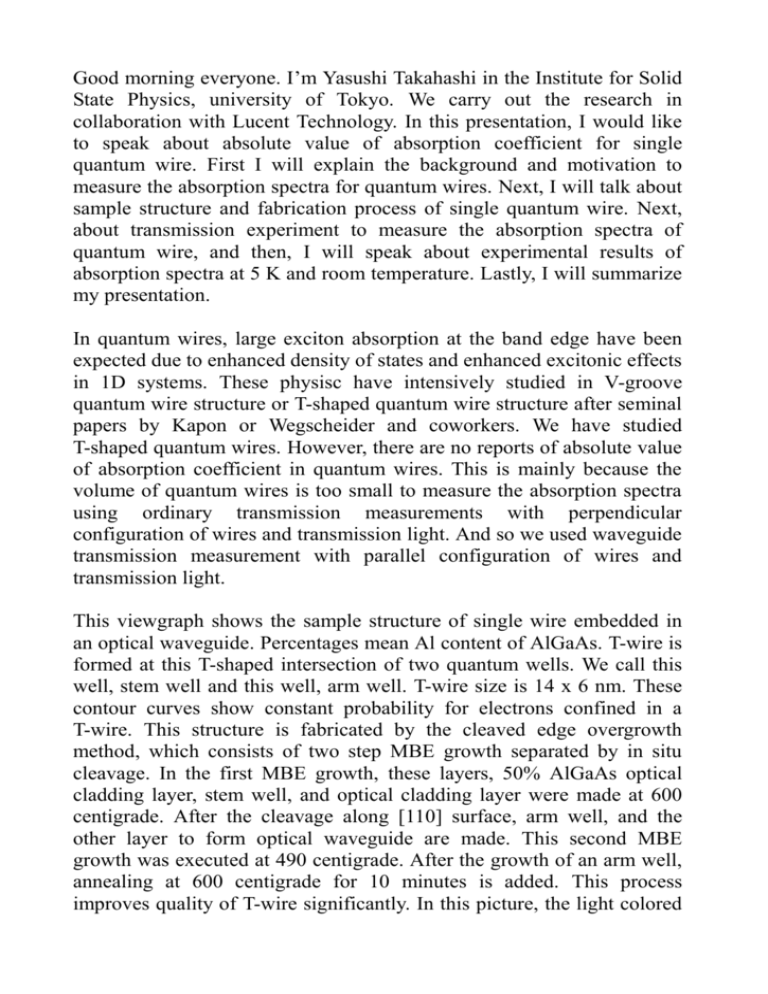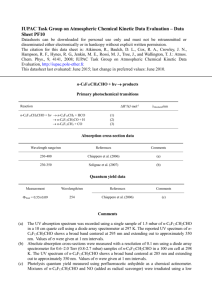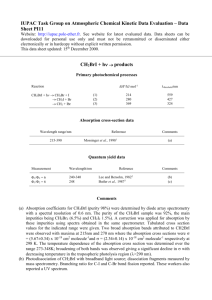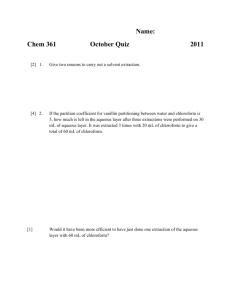My name is Yasushi Takahashi
advertisement

Good morning everyone. I’m Yasushi Takahashi in the Institute for Solid State Physics, university of Tokyo. We carry out the research in collaboration with Lucent Technology. In this presentation, I would like to speak about absolute value of absorption coefficient for single quantum wire. First I will explain the background and motivation to measure the absorption spectra for quantum wires. Next, I will talk about sample structure and fabrication process of single quantum wire. Next, about transmission experiment to measure the absorption spectra of quantum wire, and then, I will speak about experimental results of absorption spectra at 5 K and room temperature. Lastly, I will summarize my presentation. In quantum wires, large exciton absorption at the band edge have been expected due to enhanced density of states and enhanced excitonic effects in 1D systems. These physisc have intensively studied in V-groove quantum wire structure or T-shaped quantum wire structure after seminal papers by Kapon or Wegscheider and coworkers. We have studied T-shaped quantum wires. However, there are no reports of absolute value of absorption coefficient in quantum wires. This is mainly because the volume of quantum wires is too small to measure the absorption spectra using ordinary transmission measurements with perpendicular configuration of wires and transmission light. And so we used waveguide transmission measurement with parallel configuration of wires and transmission light. This viewgraph shows the sample structure of single wire embedded in an optical waveguide. Percentages mean Al content of AlGaAs. T-wire is formed at this T-shaped intersection of two quantum wells. We call this well, stem well and this well, arm well. T-wire size is 14 x 6 nm. These contour curves show constant probability for electrons confined in a T-wire. This structure is fabricated by the cleaved edge overgrowth method, which consists of two step MBE growth separated by in situ cleavage. In the first MBE growth, these layers, 50% AlGaAs optical cladding layer, stem well, and optical cladding layer were made at 600 centigrade. After the cleavage along [110] surface, arm well, and the other layer to form optical waveguide are made. This second MBE growth was executed at 490 centigrade. After the growth of an arm well, annealing at 600 centigrade for 10 minutes is added. This process improves quality of T-wire significantly. In this picture, the light colored layers have higher refractive index. Therefore, this region acts as optical waveguide, where T-wire is embedded. We calculated optical confinement factor, which is overlap ratio between the lowest optical mode and single T-wire is very small. It is smaller than multiple quantum well lasers by the factor of 400. This disadvantage may become critical drawback for optical devices. In this point, it is important to perform the direct absorption measurement for quantum wire device. The cavity length is 500 um. Two cavity mirrors are left uncoated. This presents PLE spectra of T-wires at 5 K. PLE measurement is useful to investigate spectral shape of absorption, but isn’t useful to measure the absorption coefficient. As you can see, the lowest energy peak corresponds to 1D exciton ground state, and this flat absorption is due to 1D continuum states. The purpose of my sutdy is to measure the absolute value of this peak. This figure shows the configuration of waveguide transmission experiment. The key point in this experiment is very simple, to make the transmission light interact 500 um long T-wire. This method compensate for small volume of T-wire. When Input power I0, transmitted light intensity I is attenuated by exp(-L) in single pass. L is cavity length of 500 um and the modal absorption coefficient alpha is our goal. Tunable Cw TiS laser was used as a transmission light source. Laser was focused to about 1 um diameter spot by this objective lens, and the transmitted light through the waveguide was collected by this objective lens. In order to eliminate the background light, we used single core with confocal microscope configuration. We measured incident intensity I0 removing the sample and transmitted intensity inserting the sample. We obtained transmittance I/I0. Two polarization of transmitted light were used. Arm polarization is parallel to the arm well and stem polarization is parallel to the stem well. This viewgraph shows the transmittance spectrum at 5 K for arm polarization. X-axis is photon energy, y-axis is transmittance in log scale. Strong attenuation is observed in this energy. Below this energy, clear and flat Fabry Perot oscillations are observed due to reflection. The transmittance include reflection is given by this equation. We can translate this spectrum into the absorption spectrum using this formula. and is unknown value. is modal absorption coefficient and is coupling efficiency between input laser and optical waveguide. Next, I will explain Analysis of the Fabry Perot fringes enables estimation of the coupling efficiency. This shows the magnification of Fabry Perot fringes. There is no absorption by T-wire but intrinsic waveguide loss exists. We can derive the loss using Hakki & Paoli method, which is independent of coupling efficiency and so we can introduce the waveguide loss of 3.5 cm-1. Substituting this value into this formula, we can derive coupling efficiency of 0.24. In this way, we can correctly derive the absorption spectrum from the transmittance spectrum. This graph is absorption spectrum of a single wire at 5 K for arm polarization. Longitudinal axis is modal absorption. Firstly, We obtained the same spectral shape as PLE spectrum. Therefore, this peak is due to 1D exciton ground state, and this flat structure is due to 1D continuum states, and increasing absorption above this energy is due to the arm well. In this peak, a full width at half maximum is 1.6 meV. This indicates the high uniformity of our quantum wire in the whole cavity region. Secondly, the absorption coefficient of 80 cm-1 gives transmittance of 1.8 % by a single pass of the 500 um waveguide. In other words, 98% of transmission light is absorbed by a 500 um long T-wire. This demonstrates a strong excitonic absorption of the single T-wire in spite of the small optical confinement factor. Third point, the absorption of 1D continuum is much smaller than 1D exciton peak, and the inverse square root singularity at the band edge is absent as theoretically predicted. Next, we tried to measure the absorption spectra at room temperature because room temperature excitonic absorption value is very important for practical optical devices. However, we were not able to measure it for single wire device. Thus, we used 20 wire device. This is the structure of 20 multiple T-wires. The size of T-wire is the same as single wire device. 20 T-wires are embedded in an optical waveguide in order to increase the optical confinement factor. That value is 9.3 times larger than that of single T-wire device. Coupling efficiency in transmission measurement also increases to 0.4 due to larger waveguide size. We measured room temperature absorption spectra using this device. This is the result at 297 K. The solid curve represents absorption for arm polarization. Strong and sharp absorption peak is observed. We believe this is the first observation of room temperature 1D excitonic absorption. The absolute value of 1D exciton peak is 160 cm-1. This value corresponds to transmittance of 2.8x10-4 by a single pass of the 500 um waveguide. This demonstrates that the quantum wires in an optical waveguide have a strong excitonic absorption even at room temperature. Therefore, quantum wires are applicable to optical devices. A full width at half maximum in this peak is estimated as 7.2 meV. The dotted curve represents absorption for stem polarization. Stronger absorption for arm polarization indicates that T-wires have polarization dependence similar to the arm quantum well. This characteristic originates from the strong quantum confinement in the direction of [110]. This graph shows absorption spectra for various temperatures. As increasing temperature, 1D exciton peak at 5 K changes continuously to this room temperature peak. Therefore, this experiment proves this absorption peak is due to 1D exciton. In summary, we measured absorption spectra for T-shaped quantum wires using straightforward waveguide transmission measurement. The modal absorption coefficient of 1D exciton for single T-wire is 80 cm-1 at 5 K. Room temperature 1D exciton absorption was observed. Absorption coefficient for 20 T-wires is 160 cm-1. T-wire exciton has large polarization anisotropy. I hope these results support applications of quantum wires to practical optical devices. Thank you for your attention.








